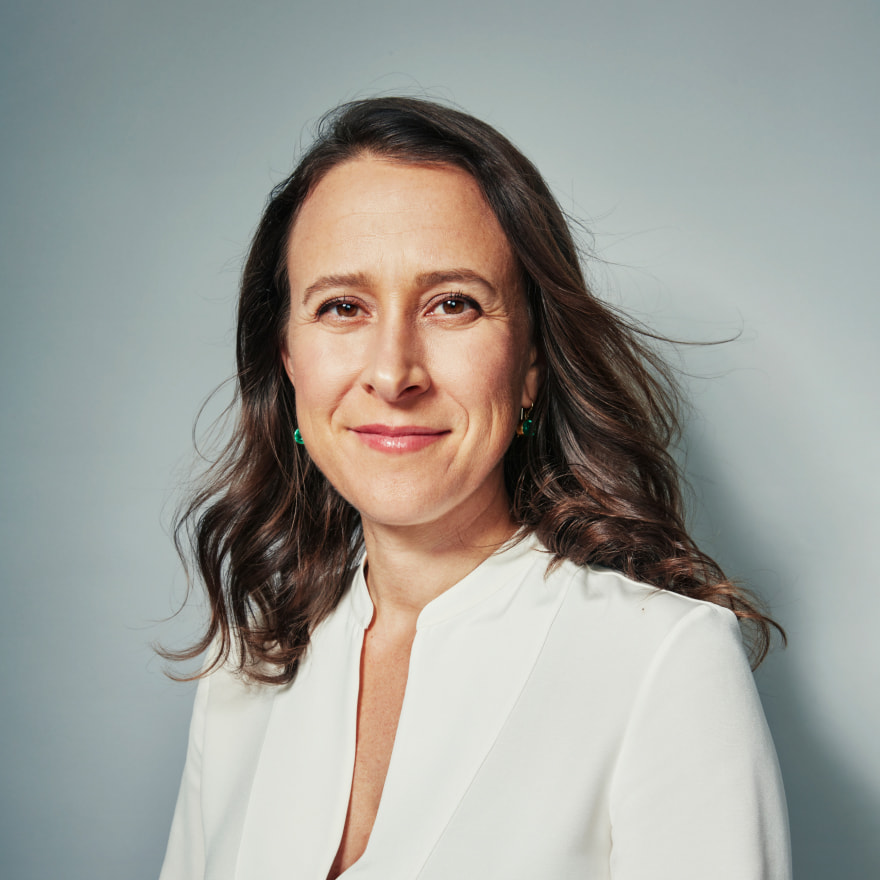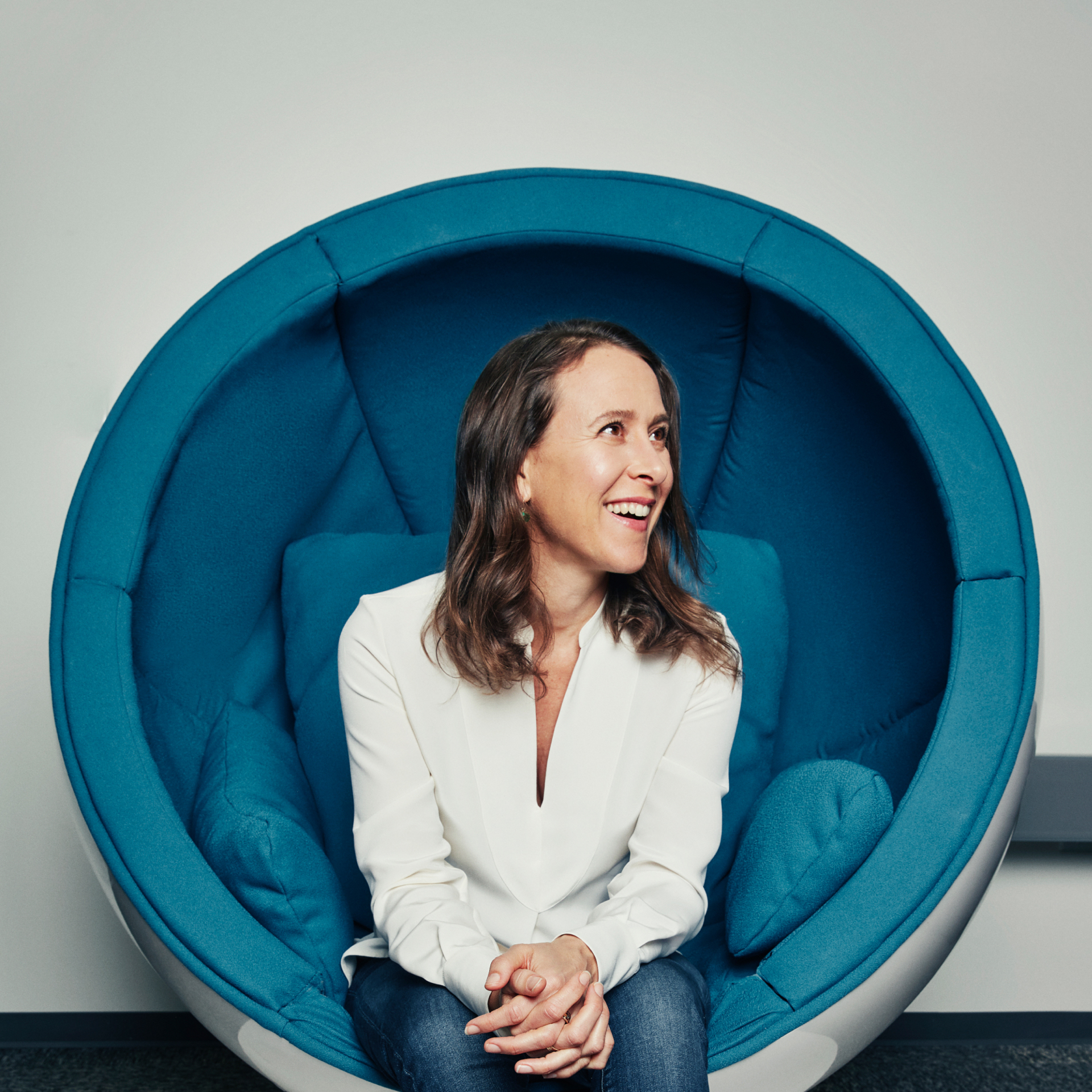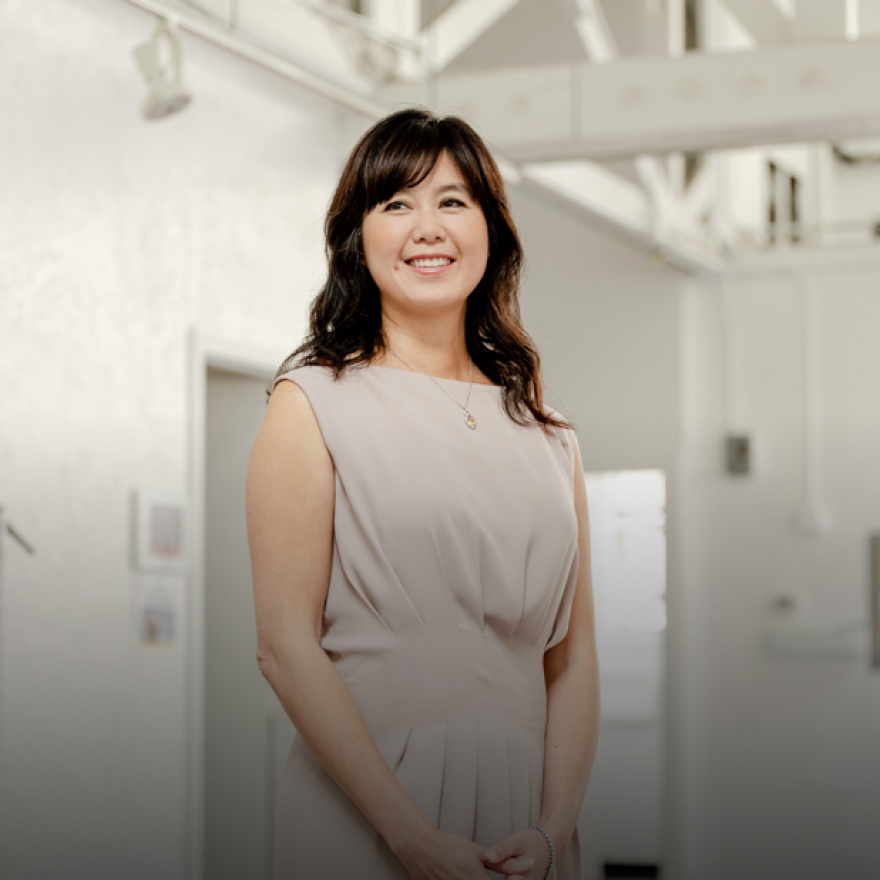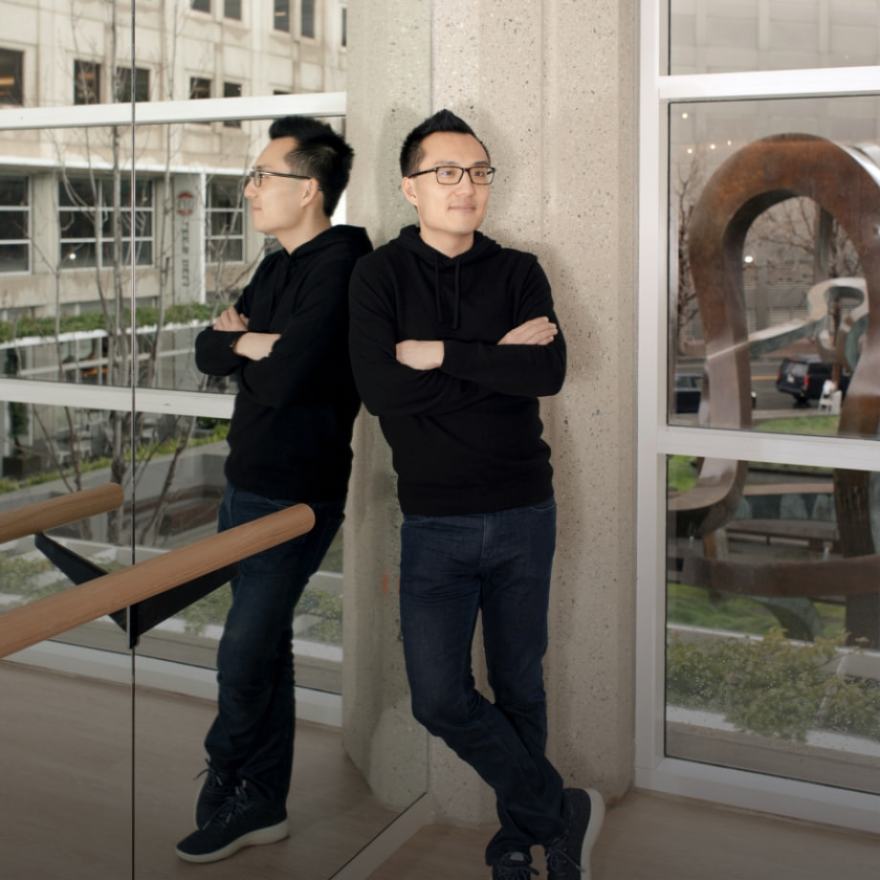A stubborn streak runs through Anne Wojcicki’s family. She traces this back to her great-grandmother, a talented singer who spent all her money going to the opera in Tsarist St. Petersburg. Wojcicki makes this out to be an all-consuming obsession: nothing could stop Leah Srubinsky from blowing the conjugal nest egg to watch people unload their lungs on stage.
“Her relatives finally said, ‘enough! The only way to stop you is to move to Siberia,’” Wojcicki says during an interview at her hillside home on the outskirts of Silicon Valley.
Pressed on whether her family had really moved all the way to Siberia because of opera, she insists it’s true. “Apparently the only way to control that DNA was total isolation,” she laughs.
As anyone who has taken grade-school biology knows, 23 pairs of chromosomes populate most cells in the human body; DNA and the four letters that comprise it—A, T, G and C—form the building blocks of life. Wojcicki, founder of pioneering DNA testing company 23andMe, sees much of the world—stubbornness included—through the lens of genetics.
“You have genes and you have environment,” Wojcicki says, reclining on her balcony in the casual garb that has long defined her personal style—puffy jacket, workout shorts and Crocs. “Your environment is always going to play a huge influence, but I do believe you’re born in certain ways.”
Wojcicki herself was born in a certain way, with the kind of background that someone who believes in fate could easily see as charting her future in advance. The product of a Polish Catholic father and Russian Jewish mother (she of the opera-loving stock), Wojcicki grew up in a household that respected tradition and prioritized connecting with one’s roots. Stories passed down about the trials her family endured during Europe’s mid-century conflicts fostered her fascination with “what-ifs” and alternate paths her forebears could have taken.
“Most of the people on my father’s side were farmers, but my grandfather was a ‘breakaway child’,” she says. “He managed to get an education and became a judge. Then he entered politics, and eventually became Secretary of the Polish People’s Party. He resisted Communism to the point that he was sent into prison, and later house arrest. While his wife and son—my father—were able to escape and come to America, my grandfather never managed to leave his home country.” While discussing this episode, she emphasizes the “random people” who helped her grandfather obtain an education in his youth, contrasting his lucky break against the zillion possible lives he could have led but didn’t.
The details of this story came to life when Wojcicki visited Poland during a gap year between high school and college, before starting a career that would see her race to the frontiers of DNA-based biotech. 23andMe has, since its founding in 2006, helped more than 13 million people uncover details about their backgrounds and amassed the second-largest genetic database of any company in the world. Wojcicki believes that big data can help solve the mysteries of DNA, but in both her Poland experience and a later backpacking trip to old family stomping grounds in Siberia, she connected most deeply with the small things: the sights, sounds and smells that shaped her ancestors.
“I was interested in a level of detail that wasn’t just surface,” she says. “I wanted to imagine myself living in those places.”
The Siberia expedition especially was a trip back in time: Wojcicki rode a train across the steppe, looking to emulate the horseback travel her ancestors had to resort to in order to escape the pogroms that saw countless Russian Jews killed or forced into exile. During this expedition, the voices of her grandparents echoed in her head, their upbringings already half-formed in her mind.
“I find that people, as they get older—especially when they’re closer to dying—start telling stories about their childhoods,” she says. “It was really interesting to see those come to life.”
This episode helped plant the seed for 23andMe’s mission. It occurred during the recession of the early 2000s, when Wojcicki, who had been working as an investor, needed to “totally detox from the Wall Street world.” Ironically, it was her early foray in finance that exposed her to the concept of health as business. Employed by the Wallenbergs, a wealthy Swedish family that ran a startup fund, she worked on their biotech portfolio, dabbling in exotic fields like xenotransplantation—inserting organs from animals (usually pigs) into humans.
“I was fascinated by questions of what you’re born with versus what you gain from your experiences.”
anne wojcicki
It was genes, however, that most enthralled her. “I was always super interested in twin studies—looking at how twins raised in different environments differ and overlap in various aspects of their lives,” she says. “I was fascinated by questions of what you’re born with versus what you gain from your experiences.”
In 2006 Wojcicki turned her need to answer these questions into 23andMe. The mapping of the human genome three years earlier had driven a wave of interest in genetic technology, and Wojcicki’s company grabbed attention instantly when it launched. 23andMe’s early publicity efforts were largely eye-catching gimmicks, such as hosting a celebrity-studded “spit party” at New York Fashion Week (the company collects its DNA samples from customers’ saliva) and launching a blimp over Silicon Valley.
Wojcicki characterizes these stunts as part of a gut-feel visibility blitz that she presided over directly. “I was the marketing department in those days,” she says, describing early advertisements she bought herself that her team still stumbles upon occasionally. Fortunately, she had a personal network seeped in the fast-moving world of Silicon Valley tech to learn from—her sister, Susan, was one of Google’s earliest employees (and served as CEO of YouTube until this year). Her husband at the time was Sergey Brin, Google’s co-founder.
“Sergey’s advice at the time was basically to just put things out there and see how people react,” Wojcicki says. This freewheeling attitude also reflected a trademark disdain for corporate stiffness that persists to this day—indeed, during one of our interviews, Wojcicki wears a joke sweatshirt with a boat sailing toward the horizon that says “F*** this, I’m out.”
Not everyone at the company embraced the early marketing approach. The scientists in particular were skeptical about it, wary of undermining the company’s credibility. At the time, the term “DNA” was rapidly entering the marketing lexicon of firms across the corporate spectrum, threatening to cheapen the image of offerings that genuinely did have DNA as their DNA.
“Our scientists would cringe at the idea of doing an infomercial, say,” Wojcicki says, citing the shopping network QVC as an example of a sales channel the company shied away from at first.
23andMe’s offbeat marketing efforts did work initially, helping sell around 1,000 test kits on their first day—an early tsunami which quickly became a trickle as the novelty wore off. Sales soon slowed to a mere handful of kits per day. Facing a still-nascent appetite for genetic technology, Wojcicki and her team doubled down on product development and user experience. Eventually a more mainstream audience caught on, drawn particularly by the prospect of discovering one’s roots, much as Anne had done on those early trips overseas. This helped the company return to a state of relatively steady growth over the next few years.
Indeed, the concept of ancestry continues to play an important role for the company today. It is the thread that connects its early trajectory to Wojcicki’s own sojourns. The connections she made with people in her ancestral homeland underscored how much potential lay in popularizing this kind of self-discovery. “I lived in a dorm when I went to Poland, and people would tell me I look more Polish than most Poles,” Wojcicki says.
“I feel like I can’t keep up with all the family that we’ve found.”
Anne Wojcicki
Unsurprisingly for someone who made a career helping millions construct family trees, her own family tree has expanded over the years, encompassing relatives from Australia to South Africa to Argentina. Ten years ago, Wojcicki’s father wrote a book about his own lineage, although no one in the family has been tasked with keeping track of every new addition to the bloodline.
“I feel like I can’t keep up with all the family that we’ve found,” she says, acknowledging that her own company’s product could potentially help her further explore her family tree’s branches and leaves. “It’s almost like there’s a present sitting at the door, but we haven’t opened it yet,” she muses. “In general, though, I’m more interested in expanding the depth, rather than the width of the tree—with making real relationships with the family members I meet.”
For her customers, gaining visibility into their own family backgrounds is a big selling point of 23andMe. (Quirky tidbits like whether they are likely to enjoy cilantro, wake up early, fear public speaking or a number of other traits come included, too.). However, more weighty assessments, such as likelihood of developing Type 2 diabetes and other more serious health conditions, are featured in its most popular service. In the years after its founding, the company expanded the repertoire of genetic conditions it screened for. Helping its customers interpret these results became a guiding principle for Wojcicki and her team.
“You have to take what’s in that raw, scientific brain and translate it to consumers,” she says, describing the late 2000s and early 2010s as a time when the company was starting to hit its stride in both its scientific mission and place in the broader discourse, when the company’s North Star—to help average people gain access to their genetic information, without what Wojcicki sees as heavy-handed intermediation by the medical establishment—was on the rise.

23andMe had defined a new category, becoming synonymous with at-home genetic testing. But along with success came detractors—including influential members of the medical community. To its skeptics, 23andMe was overly casual about revealing medical risk factors to people without giving them access to professionals who could help them handle the information. Some also question to what extent genetic analysis can truly predict diseases. Wojcicki describes attending a dinner in which a medical adviser for George W. Bush “walked out in disgust” after learning about the company’s product, and another instance in which the company was rejected from a convention held by a “major medical society” when it applied for a booth.
“I’ve been surprised by all the controversy that’s followed us,” Wojcicki says. She turns the criticism back to the healthcare industry, contrasting 23andMe’s work of promoting radical transparency with the industry’s habit of collecting patients’ data without any recourse to opt-out. “People should have choice,” she says. “The potential of genetics is really to help people know, ‘hey, here’s what your risks are, and can you actually do anything that mitigates those risks?’ I think there’s an incredible opportunity for that. You need to have the right information and awareness around [your risks], and [we can] help people understand that a probability is not the same as a predetermined outcome.”
Wojcicki has never been shy about the fact that winning over the medical establishment is not her top priority. The Food and Drug Administration (FDA), however, is another matter.
The regulatory status of 23andMe’s genetic tests was always murky in those early years. Consumer genetics was such a new space, and regulators had almost no precedent on which to base rules. Still, the relationship between 23andMe and the FDA started out amicably: Wojcicki counts David Kessler, who served as the agency’s head from 1990–97, as a friend and close advisor. The company maintained open lines of communication with the FDA throughout its rise, even as the agency maintained a relatively hands-off stance.
“When it was just a few Silicon Valley nerds buying these kits online, no one cared.”
kathy hibbs
This started to change in 2010, when a rival company began selling genetic tests at Walgreens. As Kathy Hibbs, 23andMe’s head of legal, describes it, this caused a range of power brokers—from lawmakers to regulators—to perk up their ears.
“When it was just a few Silicon Valley nerds buying these kits online, no one cared,” Hibbs says. “When it starts to look like a mass consumer product—that’s when people pay attention.”
Government engagements—including a grilling from US senators—started filling Wojcicki’s calendar. As the highest-profile consumer genetic testing company, 23andMe attracted the brightest spotlight. But the company also proved uniquely willing to place itself under scrutiny. After the FDA announced it would devise a set of rules for how such firms should engage with customers, 23andMe offered to help with the task—a big mistake, in Hibbs’ telling. “In hindsight, the company probably should’ve just stayed quiet.”
This is because it provided an opening for regulators to request ever more copious data from the company and for them to look askance at every perceived slip-up. 23andMe’s rapid growth targets and relatively lean resources during this time meant that fulfilling sales orders took priority over the cumbersome process of filling out regulatory documents. “They didn’t brush off the FDA intentionally,” Hibbs says. “It was more, ‘We’re a small company and have to get ready for the holidays.’”
Get the best stories from the Sequoia community.
As the FDA started growing impatient, 23andMe failed to grasp the agency’s increasingly strident tone. “They simply didn’t speak the same language,” Hibbs explains. “Someone should do dramatic readings of the calls from that time—you could have John Lithgow on one side and Glenn Close on the other. They were really talking past each other.”
The FDA’s restraint eventually crumbled. It was Friday, November 22, 2013. 23andMe was flush with optimism: it had recently broken a sales goal and was sitting on over $100 million in venture funding. Wojcicki was at a company offsite when her assistant texted that she’d received a letter from the FDA. Wojcicki immediately had a bad feeling. “Don’t sign for it,” she texted back, preferring for it to languish in a mail storage facility so “I could at least enjoy my weekend,” she says with a laugh.
But Wojcicki was too late. The letter was a strongly-worded order for 23andMe to immediately stop promoting its product. Its intent and tone were crystal clear. “Some of the uses for which [the product] is intended are particularly concerning,” the letter read. “Even after many interactions with 23andMe, we still do not have any assurance that the firm has analytically or clinically validated [the product] for its intended uses. Therefore, 23andMe must immediately discontinue marketing [it] until such time as it receives FDA marketing authorization.”
Wojcicki’s first instinct was to fight. She thought of suing the FDA. Her second instinct was to call everyone she knew who might be able to help. This proved wise: when she spoke with Kessler, the former FDA commissioner, he told her in no uncertain terms that if she defied the order, she would go to jail. Hibbs hedges on this somewhat, but agrees that criminal charges could follow. “It was like a bad breakup letter,” Hibbs says. “Most companies don’t come back from letters like that.”
“I’m so used to being the straight-A student—I became obsessed with proving them wrong.”
anne Wojcicki
The insult turned into injury when, in an unusual move, the agency posted the letter on its website the following Monday, attracting widespread media coverage. A sense of crisis swept through the company. Its then-head of communications resigned. But Wojcicki held firm. “They were insinuating that our product was harmful,” she says. “I’m so used to being the straight-A student—I became obsessed with proving them wrong.”
Tapping her personal network, she poached Hibbs from her post at another genetic testing company, tasking her with leading the effort to win FDA approval. The crux of the challenge was proving that consumers could grasp the implications of uncovering facts about their genome without a doctor in the chain of communication. It is a hurdle makers of over-the-counter pills like Tylenol have to overcome every time they market a new product: can shoppers understand how to take the medication? Do they appreciate the risks and know how to minimize them?
No maker of direct-to-consumer DNA tests had ever grappled with these kinds of questions. According to Wojcicki, many of them employ a “doc in the box” model, in which an invisible doctor rubber-stamps the delivery of a genetic report every time an average Jane requests it. This raises cost and inconvenience. Worse yet, it presumes people are incapable of digesting fundamental information about their own genome. Hibbs compares this to the heavy resistance healthcare bigwigs showed toward at-home pregnancy tests when they first emerged. “The medical establishment fought those tests for years,” Hibbs says. “They honestly thought women could not handle receiving this information at home alone. It is ironic that this situation was playing out again even after people fought so hard to let women read their own pregnancy tests.”
The months following the FDA letter were a hectic scramble to collect this user data through comprehension studies—focus groups where people demonstrate their understanding of a medical product. The data has to be collected in a way that satisfies the FDA’s requirements for diversity, rigor and statistical significance. All told, 23andMe surveyed thousands of people across a wide demographic, even as it was losing money and unable to bring in new revenue due to the moratorium on marketing.
Frustration simmered within the company throughout the saga. Wojcicki, however, was determined to see the setback as an opportunity to not just tick regulatory boxes, but to spark a paradigm shift in the relationship between consumers and their medical information. “The average FDA submission of this type is a few hundred pages; ours was over 7,000,” Wojcicki says—a deluge of data that was meant to prod exactly this kind of broader reckoning. Wojcicki now believes that it paved the way for more breakthroughs in data transparency, such as a federal regulation issued in 2014 that requires medical providers to send patients their lab results the same time they send them to the doctor.
“I’m the kind of person who snaps into action in these kinds of situations.”
anne Wojcicki
Ultimately, what might have constituted an existential crisis to a less committed CEO never rattled Wojcicki. “I’m the kind of person who snaps into action in these kinds of situations,” she says. “My only real worry was how long it was going to take.” Indeed, the company spent well over a year in the wilderness: after painstakingly collecting the data in the months after receiving the cease-and-desist letter, it submitted its application to the FDA in June 2014. In February 2015, it received regulatory authorization to market a genetic health test directly to consumers.
“I have a level of stubbornness that’s apparent to anyone who knows me,” Wojcicki says. Roelof Botha, the Sequoia partner who works with 23andMe and helped it go public in 2021, cites this mix of pragmatism and dogged determination among Wojcicki’s best qualities. “She’s unconventional, but she’s also totally unpretentious,” he says. “She has obviously been very successful, and she is just who she is and very comfortable in her own skin—what you see is what you get. And that makes for a very efficient business relationship, because there’s very little pretense, very little bravado. She’s just direct.”
Botha now sees promise in 23andMe’s current mandate to leverage its massive genetic database to develop treatments for illnesses; in 2018 the company entered into a partnership with British pharmaceuticals giant GSK to discover and develop drugs based on genetic information in 23andMe’s DNA library from customers who agreed it could be used for this purpose. “I look forward to having several blockbuster drugs a decade from now,” Botha says. “That to me is the real vision and potential of the company.”
That 23andMe not only continues to dominate its field but could eventually evolve into a pharmaceuticals powerhouse is a testament to its integrity in an industry where principles and profit sometimes make for uneasy bedfellows. Our conversations take place during the trial of Elizabeth Holmes, of Theranos infamy—a cautionary tale about how wrong things can go in biotech without a commitment to integrity. Many have placed gender at the heart of the Theranos controversy. Wojcicki permits that gender played a role in the scandal but is hesitant to ascribe specific meaning to it. “I have no doubt it would have been different if she was a man, but I don’t know exactly how,” she says.
The question of gender has followed Wojcicki’s own career since it started. She emphasizes the importance of elevating women in her organization, even agreeing when asked if she would prefer that the next leader of 23andMe—as far off as that might be—is a woman. Equality is her top priority, however, and she acknowledges that the pendulum can swing too far in the opposite direction: in 23andMe’s early days, the company had “too many women,” as Wojcicki puts it. “We reached a point where I was like, ‘I need men to balance it out!’,” she recalls. “Women tend to flock to work with other women, especially when they’re coming from these heavily male-dominated places.”
One place that certainly was not male dominated was Wojcicki’s childhood home, where she and her two sisters enjoyed a relationship with their parents in which the very idea of “dominance” was completely alien. Her mother Esther, a former teacher who recently published a book about raising successful children, frequently writes and speaks about the importance of questioning authority and challenging preconceived notions of who gets to call the shots.
This ethos forms the core of how Wojcicki now leads 23andMe, whose culture she describes as one of cooperation and willingness to participate in non-ego driven pursuits. It is also one where scientific inquisitiveness and a desire to constantly push the boundaries of discovery are more important than always finding the “right” answer.
“We are very much about recognizing interesting problems and coming up with collective solutions. Sometimes I find people with the right DNA for us, who didn’t flourish because they weren’t in the right environment, but who go on to flourish with us.”
Framing her management ethos in terms of those age-old dance partners—DNA and environment—is of a piece with Wojcicki’s overall worldview, one in which genes and circumstances interact to create a whole human being, in which exploring where one factor begins and the other ends is worthy of a category-defining company and mountains of scientific innovation. Yet despite this audacious ambition, the energy in Wojcicki’s voice as she describes her experiences discovering her roots belies a more down-to-earth motivation: the need to simply and deeply comprehend one’s place in the world.
“Going back to see my father’s hometown, to the apartment he lived in, to taste the food he ate…in the back of my mind I was always thinking, ‘what if it was me?’”


